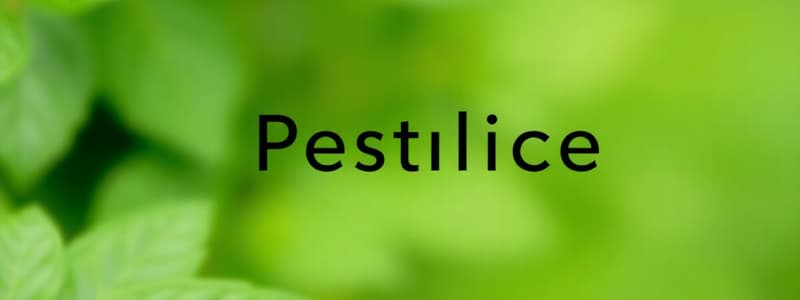Podcast
Questions and Answers
Which of the following best describes the role of the International Union of Pure and Applied Chemistry (IUPAC) in pesticide nomenclature?
Which of the following best describes the role of the International Union of Pure and Applied Chemistry (IUPAC) in pesticide nomenclature?
- Establishing a set of systematic rules for generating chemical names for chemical compounds. (correct)
- Developing the trade names under which pesticides are marketed to ensure brand recognition.
- Regulating the registration and proprietary protection of pesticide products in the Philippines.
- Creating simplified common names for pesticides used globally to ease communication among users.
How do experimental pesticide names, such as DPX-E2Y45, primarily function during the research and development phase?
How do experimental pesticide names, such as DPX-E2Y45, primarily function during the research and development phase?
- They serve as the brand name for commercial sale, attracting consumer attention.
- They serve as code names to identify active ingredients before patenting and commercialization. (correct)
- They provide a legal basis for patent protection of the active ingredient.
- They act as the official IUPAC name, ensuring standardized chemical nomenclature.
What is the primary goal of assigning common names, such as glyphosate, to pesticides by organizations like ISO or ANSI?
What is the primary goal of assigning common names, such as glyphosate, to pesticides by organizations like ISO or ANSI?
- To establish a unique brand identity for marketing purposes, creating consumer loyalty.
- To simplify the use of complex chemical names, making the products more accessible to individuals without technical expertise. (correct)
- To comply with international trade regulations and standards for chemical exports.
- To ensure that the pesticide can be easily identified by scientists for advanced research purposes.
What is the significance of proprietary protection in the context of pesticide registration, as granted by the Intellectual Property Office of the Philippines (IPOPHL)?
What is the significance of proprietary protection in the context of pesticide registration, as granted by the Intellectual Property Office of the Philippines (IPOPHL)?
How does the Principle of Prior Informed Consent (PIC) influence the regulation of banned pesticides in the Philippines?
How does the Principle of Prior Informed Consent (PIC) influence the regulation of banned pesticides in the Philippines?
What criteria does the FPA consider when categorizing a pesticide under 'Restriction Due to Health Hazards'?
What criteria does the FPA consider when categorizing a pesticide under 'Restriction Due to Health Hazards'?
Under what circumstances would the FPA impose a 'Restriction to Gather More Information' on a pesticide?
Under what circumstances would the FPA impose a 'Restriction to Gather More Information' on a pesticide?
Which factor differentiates institutional users from ordinary farmers in the context of pesticide application, according to the FPA?
Which factor differentiates institutional users from ordinary farmers in the context of pesticide application, according to the FPA?
According to PD 1144, under what condition are restricted pesticides permitted for use?
According to PD 1144, under what condition are restricted pesticides permitted for use?
What is the primary purpose of training programs for agricultural certified pesticide applicators?
What is the primary purpose of training programs for agricultural certified pesticide applicators?
What is the main implication of the statement: 'The TOXICITY category does not equal to the toxicity to target pests'?
What is the main implication of the statement: 'The TOXICITY category does not equal to the toxicity to target pests'?
How does the FPA classify pesticides based on their nature and use pattern?
How does the FPA classify pesticides based on their nature and use pattern?
What does the term 'Biorational Pesticides' refer to?
What does the term 'Biorational Pesticides' refer to?
What is meant by 'Pesticide formulations'?
What is meant by 'Pesticide formulations'?
Why is the development of a 'resistance management code' critical for crop protection?
Why is the development of a 'resistance management code' critical for crop protection?
Why should labels and educating the pesticide decision maker and applicator be understood by pesticide handlers?
Why should labels and educating the pesticide decision maker and applicator be understood by pesticide handlers?
What role does the Resistance Action Committee (RAC) play in pesticide management?
What role does the Resistance Action Committee (RAC) play in pesticide management?
What does MoA stand for in the context of pesticide resistance management?
What does MoA stand for in the context of pesticide resistance management?
According to the document, what is true regarding methods and products used for disinfection?
According to the document, what is true regarding methods and products used for disinfection?
In relation to data protection, which data is granted 3-year data protection upon approval?
In relation to data protection, which data is granted 3-year data protection upon approval?
Flashcards
Pesticide (in PD 1144)
Pesticide (in PD 1144)
Any substance or mixture to control, prevent, destroy, repel, or mitigate any pest.
Chemical nomenclature
Chemical nomenclature
Systematic naming of chemical compounds, developed by the International Union of Pure and Applied Chemistry.
Chemical common names
Chemical common names
Simplified chemical names accepted globally or regionally (ISO, ANSI) to aid understanding.
Experimental names
Experimental names
Signup and view all the flashcards
Trade names
Trade names
Signup and view all the flashcards
Proprietary pesticides
Proprietary pesticides
Signup and view all the flashcards
Patent
Patent
Signup and view all the flashcards
Banned pesticides
Banned pesticides
Signup and view all the flashcards
Restricted pesticides (health)
Restricted pesticides (health)
Signup and view all the flashcards
Restricted pesticides, Gather Info
Restricted pesticides, Gather Info
Signup and view all the flashcards
Restricted pesticides (institutional)
Restricted pesticides (institutional)
Signup and view all the flashcards
Applicator Restricted pesticides
Applicator Restricted pesticides
Signup and view all the flashcards
Drone pesticide restrictions
Drone pesticide restrictions
Signup and view all the flashcards
Pesticide categories
Pesticide categories
Signup and view all the flashcards
Other chemical pesticides
Other chemical pesticides
Signup and view all the flashcards
Biorational pesticides
Biorational pesticides
Signup and view all the flashcards
Pesticide formulation
Pesticide formulation
Signup and view all the flashcards
Pesticide resistance management
Pesticide resistance management
Signup and view all the flashcards
Disinfectant use guidelines
Disinfectant use guidelines
Signup and view all the flashcards
Common disinfectant groups
Common disinfectant groups
Signup and view all the flashcards
Study Notes
- The term pesticide includes active ingredients, adjuvants, and pesticide formulations, intended to control, prevent, destroy, repel, or mitigate any pest.
- Understanding pesticide names and classifications is necessary for managing risks to humans and the environment while using pesticides.
Pesticide Nomenclature
- Pesticide nomenclature involves identifying pesticides by their chemical and common names.
- Everything is made of chemicals.
- Chemical nomenclature utilizes systematic rules to name chemical compounds, often following guidelines from the International Union of Pure and Applied Chemistry (IUPAC).
- IUPAC names are not typically found on pesticide labels but may be in the material safety data sheet (MSDS/SDS).
- Common names, like mancozeb, glyphosate, and cypermethrin, simplify chemical names and are accepted globally by organizations like ISO and ANSI to promote understanding.
- Common names provide a reference for people with or without a technical background.
Experimental Names
- Experimental names are assigned to molecules with pesticidal action during research.
- An analogue is a chemical compound structurally similar to another but with slight compositional differences.
- For example, DPX-E2Y45 was an experimental code name for chlorantraniliprole.
- DPX denotes the company (DuPont), and E2Y45 represents the specific active ingredient patented.
Trade Names
- Trade names are given by manufacturers for commercialization
- They establish brand presence in the marketplace.
- Chlorantraniliprole is branded as RynaxypyrTM, appearing in products like PrevathonTM 5SC.
- Other licensed products can use the common name on labels, but RynaxypyrTM and chlorantraniliprole are essentially the same.
Pesticide Classifications - Registration Data Protection
- Proprietary pesticide products are those whose patent and registration data have not expired, allowing the original registrant to exclusively manufacture the product.
- A patent is a legal right granted by the government to inventors for disclosing an invention, allowing exclusive exploitation for 20 years from filing, without renewal.
- Maximizing the opportunity to return the investment and profit will not be the whole 20 year period.
- The FPA provides data protection.
Restriction Categories
- Banned pesticides cannot be brought into or used in the country under any circumstances.
- This includes pesticides found unacceptable for use or voluntarily withdrawn.
- Banned pesticides in other countries may be allowed under the Principle of Prior Informed Consent (PIC).
- Restriction categories also include health hazards and the need to gather more information.
- Restriction is determined by factors like toxicity, antidotes, carcinogenicity, and environmental properties.
- Compounds believed to have potential adverse effects are monitored to obtain local experience under controlled conditions.
- Restrictions due to phytotoxicity to crops are applicable to herbicides.
- Restrictions in the circumstances where the tolerance of a crop to a particular herbicide is dependent upon certain conditions which may not be followed under ordinary farmer's field conditions.
Pesticides for Institutional Use Only
- The use of these pesticides is limited to institutions.
- Institutional users exercise close supervision of pesticide application.
- Occupational exposure can be limited to smaller and more homogeneous groups.
- Protective clothing requirements, exposure times and other safety factors can be more readily managed.
- Pesticides for institutional use are made available directly from the distributor/importer to the institution, without over-the-counter sales.
- Restrictions may be removed if sufficient information is generated.
Pesticides for Certified Pesticide Applicator Use Only
- Restricted pesticides should be used and applied only by or under the supervision of certified pesticide applicators.
Applicator Training and RPAS
- Training programs educate on proper use and handling of pesticides as certified applicators.
- RPAS (drone) operators applying pesticides need AgCPA certification per FPA Memorandum Circular No. 28 s. 2018.
- RPAS AgCPAs should only apply pesticides registered with FPA for RPAS use.
- Guidelines for registration of drone use products are in the 2020 FPA Greenbook.
Pesticides Based on Nature and Use Pattern
- Toxicity categories are classified, based on toxicity and hazard.
- The hazard referred to is generally the acute risk to health.
- The toxicity category does not equal to the toxicity to target pests.
- There are (424 total) registered pesticides as solo or mixed active ingredient combinations, based on August 2022 FPA data.
- Only 4 are in Category I, mainly for fumigation, requiring special training.
- Category II has 79.
- Category III has 64.
- Category IV has 256.
- There are 21 without classification.
Chemical Peticides
- Chemical pesticides are classified for registration purposes under FPA Greenbook section 2.1.4.
Chemical Pesticide Types
- Agriculture/Home Garden/Turf Use pesticides include insecticides, fungicides, herbicides, rodenticides, nematicides, bactericides, molluscicides, and acaricides (miticides).
- Other chemical pesticides, used alone or in combination, include growth regulators, defoliants, desiccants, systemic activators of resistance, surfactants/adjuvants, emulsifiers, wetting agents, penetrants, synergists, and agricultural disinfectants.
Biorational Pesticides
- Biorational pesticides include biochemical pest control agents and microbial pest control agents.
- Biochemical agents include semiochemicals like pheromones, kairomones, and allomones, as well as hormones, natural plant regulators (auxins), and enzymes.
- Microbial agents include bacterium, fungus, protozoa, and virus.
- Plant-incorporated protectants (PIPs) can be single or combined/stacked.
- Chemical synthesized pesticides dominate the market, limiting opportunity for biorational pesticides.
Pesticide Formulations
- FAO defines formulation as the combination of ingredients designed to render a product useful and effective.
- Pesticides can be liquid or solid.
- A pesticide may not have more than one formulation due to the active ingredient properties.
Resistance Management Code
- Resistance development is critical for crop protection.
- Repeated use of pesticides with the same mode of action (MoA) increases pest resistance.
- Sequential applications or mixtures with different MoA's delays resistance.
- The time interval between new active ingredients is lengthy.
- The FPA includes MoA number guidance on pesticide labels from the Resistance Action Committee (RAC).
- Labels and education are key to resistance management.
Disinfectants
- Methods and products for disinfection are now under FPA's jurisdiction.
- Disinfectants can be used alone or in combinations.
- Users should read labels for correct product selection.
- Disinfectants are not interchangeable.
- Common groups include alcohol, chlorine compounds, formaldehyde, glutaraldehyde, hydrogen peroxide, iodophors, ortho-phthalaldehyde (OPA), peracetic acid, peracetic acid with hydrogen peroxide, phenolics, and quaternary ammonium compounds.
Studying That Suits You
Use AI to generate personalized quizzes and flashcards to suit your learning preferences.




